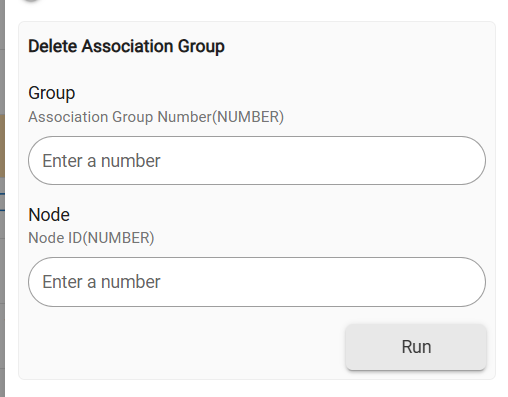Updated this driver to include set and delete associations
/*
Basic Z-Wave tool updated by Anitesh Kumar (added set and delete associations)
Copyright 2016 -> 2020 Hubitat Inc. All Rights Reserved
2020-08-14 maxwell
-refactor
-update VersionReport
2020-08-12 maxwell
-update with S2 support
2018-11-28 maxwell
-add command hints
2018-11-09 maxwell
-add association and version reports
usage:
-replace existing driver with this driver
-set your paremeters
-replace this driver with previous driver
WARNING!
--Setting device parameters is an advanced feature, randomly poking values to a device
can lead to unexpected results which may result in needing to perform a factory reset
or possibly bricking the device
--Refer to the device documentation for the correct parameters and values for your specific device
--Hubitat cannot be held responsible for misuse of this tool or any unexpected results generated by its use
*/
import groovy.transform.Field
metadata {
definition (name: "Basic Z-Wave tool",namespace: "hubitat", author: "Mike Maxwell") {
command "getAssociationReport"
command "setAssociationGroup", [[name: "groupingIdentifier", type: "NUMBER", description: "Association Group Number", constraints: ["NUMBER"]],
[name: "nodeId", type: "STRING", description: "Comma-separated list of node IDs"]]
command "deleteAssociationGroup", [[name: "group", type: "NUMBER", description: "Association Group Number", constraints: ["NUMBER"]],
[name: "node", type: "NUMBER", description: "Node ID", constraints: ["NUMBER"]]]
command "getVersionReport"
command "getCommandClassReport"
command "getParameterReport", [[name:"parameterNumber",type:"NUMBER", description:"Parameter Number (omit for a complete listing of parameters that have been set)", constraints:["NUMBER"]]]
command "setParameter",[[name:"parameterNumber",type:"NUMBER", description:"Parameter Number", constraints:["NUMBER"]],[name:"size",type:"NUMBER", description:"Parameter Size", constraints:["NUMBER"]],[name:"value",type:"NUMBER", description:"Parameter Value", constraints:["NUMBER"]]]
}
}
@Field Map zwLibType = [
0:"N/A",1:"Static Controller",2:"Controller",3:"Enhanced Slave",4:"Slave",5:"Installer",
6:"Routing Slave",7:"Bridge Controller",8:"Device Under Test (DUT)",9:"N/A",10:"AV Remote",11:"AV Device"
]
void parse(String description) {
hubitat.zwave.Command cmd = zwave.parse(description,[0x85:1,0x86:2])
if (cmd) {
zwaveEvent(cmd)
}
}
//Z-Wave responses
void zwaveEvent(hubitat.zwave.commands.versionv2.VersionReport cmd) {
Double firmware0Version = cmd.firmware0Version + (cmd.firmware0SubVersion / 100)
Double protocolVersion = cmd.zWaveProtocolVersion + (cmd.zWaveProtocolSubVersion / 100)
log.info "Version Report - FirmwareVersion: ${firmware0Version}, ProtocolVersion: ${protocolVersion}, HardwareVersion: ${cmd.hardwareVersion}"
device.updateDataValue("firmwareVersion", "${firmware0Version}")
device.updateDataValue("protocolVersion", "${protocolVersion}")
device.updateDataValue("hardwareVersion", "${cmd.hardwareVersion}")
if (cmd.firmwareTargets > 0) {
cmd.targetVersions.each { target ->
Double targetVersion = target.version + (target.subVersion / 100)
device.updateDataValue("firmware${target.target}Version", "${targetVersion}")
}
}
}
void zwaveEvent(hubitat.zwave.commands.associationv1.AssociationReport cmd) {
log.info "AssociationReport- groupingIdentifier:${cmd.groupingIdentifier}, maxNodesSupported:${cmd.maxNodesSupported}, nodes:${cmd.nodeId}"
}
void zwaveEvent(hubitat.zwave.commands.configurationv1.ConfigurationReport cmd) {
log.info "ConfigurationReport- parameterNumber:${cmd.parameterNumber}, size:${cmd.size}, value:${cmd.scaledConfigurationValue}"
}
void zwaveEvent(hubitat.zwave.commands.versionv1.VersionCommandClassReport cmd) {
log.info "CommandClassReport- class:${ "0x${intToHexStr(cmd.requestedCommandClass)}" }, version:${cmd.commandClassVersion}"
}
String zwaveEvent(hubitat.zwave.commands.securityv1.SecurityMessageEncapsulation cmd) {
hubitat.zwave.Command encapCmd = cmd.encapsulatedCommand()
if (encapCmd) {
return zwaveEvent(encapCmd)
} else {
log.warn "Unable to extract encapsulated cmd from ${cmd}"
}
}
void zwaveEvent(hubitat.zwave.Command cmd) {
log.debug "skip: ${cmd}"
}
//cmds
def getVersionReport(){
return secureCmd(zwave.versionV1.versionGet())
}
List<String> setParameter(parameterNumber = null, size = null, value = null){
if (parameterNumber == null || size == null || value == null) {
log.warn "incomplete parameter list supplied..."
log.info "syntax: setParameter(parameterNumber,size,value)"
} else {
return delayBetween([
secureCmd(zwave.configurationV1.configurationSet(scaledConfigurationValue: value, parameterNumber: parameterNumber, size: size)),
secureCmd(zwave.configurationV1.configurationGet(parameterNumber: parameterNumber))
],500)
}
}
List<String> getAssociationReport(){
List<String> cmds = []
1.upto(5, {
cmds.add(secureCmd(zwave.associationV1.associationGet(groupingIdentifier: it)))
})
return delayBetween(cmds,500)
}
List<String> setAssociationGroup(group, node) {
Integer groupNum = group as Integer
Integer nodeNum = node as Integer
if (groupNum == null || nodeNum == null) {
log.warn "Incomplete association group parameters supplied..."
log.info "Syntax: setAssociationGroup(group, node)"
} else {
return delayBetween([
secureCmd(zwave.associationV1.associationSet(groupingIdentifier: groupNum, nodeId: [nodeNum])),
secureCmd(zwave.associationV1.associationGet(groupingIdentifier: groupNum))
], 500)
}
}
List<String> deleteAssociationGroup(group, node) {
Integer groupNum = group as Integer
Integer nodeNum = node as Integer
if (groupNum == null || nodeNum == null) {
log.warn "Incomplete association group parameters supplied..."
log.info "Syntax: deleteAssociationGroup(group, node)"
} else {
return delayBetween([
secureCmd(zwave.associationV1.associationRemove(groupingIdentifier: groupNum, nodeId: [nodeNum])),
secureCmd(zwave.associationV1.associationGet(groupingIdentifier: groupNum))
], 500)
}
}
List<String> getParameterReport(param = null){
List<String> cmds = []
if (param != null) {
cmds = [secureCmd(zwave.configurationV1.configurationGet(parameterNumber: param))]
} else {
0.upto(255, {
cmds.add(secureCmd(zwave.configurationV1.configurationGet(parameterNumber: it)))
})
}
log.trace "configurationGet command(s) sent..."
return delayBetween(cmds,500)
}
List<String> getCommandClassReport(){
List<String> cmds = []
List<Integer> ic = getDataValue("inClusters").split(",").collect{ hexStrToUnsignedInt(it) }
ic.each {
if (it) cmds.add(secureCmd(zwave.versionV1.versionCommandClassGet(requestedCommandClass:it)))
}
return delayBetween(cmds,500)
}
String secure(String cmd){
return zwaveSecureEncap(cmd)
}
String secure(hubitat.zwave.Command cmd){
return zwaveSecureEncap(cmd)
}
void installed(){}
void configure() {}
void updated() {}
String secureCmd(cmd) {
if (getDataValue("zwaveSecurePairingComplete") == "true" && getDataValue("S2") == null) {
return zwave.securityV1.securityMessageEncapsulation().encapsulate(cmd).format()
} else {
return secure(cmd)
}
}



